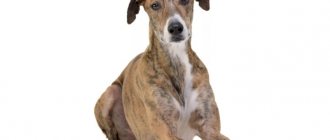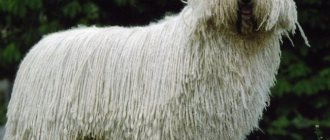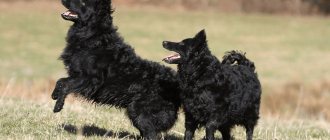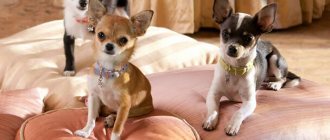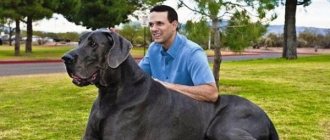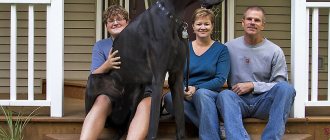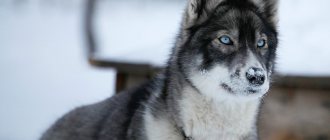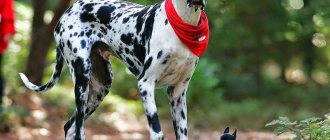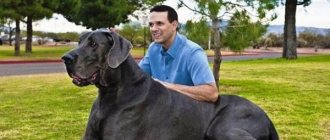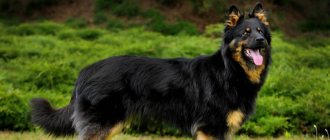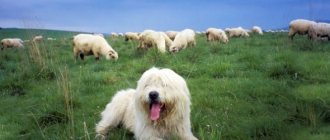History of the origin of the breed
There is little information about where and when this shaggy shepherd with dreadlocks was bred. Most likely, the Komondor began to live next to humans more than a thousand years ago. The first homeland of dogs is considered to be one of the regions of the Black Sea, where, living in a house next to people, they helped them herd cattle. Later, the dogs moved towards Hungary, where the formation of the breed took place.
As for ancestors, special types of sheep and wild wolves are recorded in the unofficial pedigree of Komondors. Such an unusual crossing could really give the dog its bright appearance, but scientists are still inclined to the fact that the ancestors of the Hungarian were ancient shepherd dogs and wolves.
The spread of Hungarians around the world was simultaneous in European countries and America. In this regard, there was often a mixture of breeds, but the established standard of Hungarian Shepherds is very strict and allows little deviation from the norm.
Keeping a Komondor
Such a large animal as the Hungarian Shepherd needs a huge and securely fenced living space. Such a dog should live outside all year round; its thick coat will protect it from any weather. You just need to equip a fairly spacious insulated booth. Such conditions can be provided in a private or country house, as well as in a farmstead where there is a large courtyard or area (aviary).
Komondors are absolutely not suitable for apartment living. They will be extremely uncomfortable in a confined space, and besides, the dogs will sweep away everything in their path.
Description of the breed
Komondors are large dogs. Their height at the withers reaches 80 cm in males and 70 in females. At the same time, the average weight is about 50 kg, although heavier representatives are also found. In general, a feature of the Hungarian standard is the fact that the size of dogs is not limited. The larger and more muscular the dog, the higher its price.
The entire body, including the head, is covered with long, thick hair twisted into strands. The coat color can be white or slightly gray. Small dark eyes are always hidden by hair, and triangular ears hang along the cheeks. The tail is carried down, although the dense fur prevents this from being visible.
The body is strong and muscular, but due to the fact that the coat is very voluminous, it can be difficult to see its true dimensions. The neck is high and level, and the chest, although not too wide, is very powerful. The paws are strong and as muscular as the rest of the body.
Mating
- Breeding large dogs is hard work. Most often, breeders are either experienced specialists themselves or invite them to carry out the procedure. Puberty occurs at 8-12 months , but mating is allowed only at 20 months , so that the organisms of both dogs can conceive and bear healthy offspring.
- The bitches should already be in their third heat, mating is carried out 13-15 days from the beginning, when the loop swells greatly and the discharge becomes lighter. Since the Komondor population is small, almost all matings are breeding. Pets are cleaned of helminths and checked for pathologies.
- You need to walk the dogs together and see their reaction. If they have accepted each other, then you can move on to the second part: the girl is brought to the dog’s territory. There should be a lot of free space to make the pets comfortable. The act lasts 15-20 minutes , the lock from 5 to 40 . When locking for a long time, you need to choose a position so that the shepherd dogs are not injured. Repeated mating is carried out after 2 days.
Character and behavioral characteristics
The character of the Hungarians is as unusual as their appearance. On the one hand, these are active, friendly dogs that behave like puppies even in adulthood. On the other hand, there are freedom-loving animals with a fighting or hunting disposition.
Hungarians usually feel dependent on their owner, and therefore behave well-mannered in his presence. But once out of the strict control of the owner's eyes, the dog may show some aggression. They are very friendly towards children, as well as other pets. Often they strive to take care of both, for which they do not allow them to get far from them.
An interesting thing about the character of adult Hungarians is the lack of need for frequent games. As soon as the puppy grows up, he can spend his time quite sedately and calmly, without forcing the owner to take long and active walks with energetic games.
Reviews
Reviews from breeders will help you make your final decision about purchasing puppies.
Alexander:
The untidiness created by dreadlocks causes laughter and misunderstanding among many. Not everyone recognizes such a pet, and its hyperactivity is sometimes even frightening. Personally, I find it funny, and understanding each other at a glance causes sincere pride. I would not recommend having a pet in a one-room apartment or studio. The Komondor needs room for its fast and restless paws. But for those who are looking for a guard dog, the choice is obvious. If you still have doubts about children, then do not be afraid - the dog loves them.
Natalia:
The dog appeared in our house after visiting friends for their daughter’s birthday. When my little one saw the gift, we immediately understood everything - it was time to save money. The Komondor caused great delight among all the gathered children. He ran with them with pleasure, was not angry at their pranks and showed friendliness with his entire appearance. After the purchase, only one flaw was identified - walking in the rain. On such days we work not for bread, but for dog shampoos! During water procedures, the pet behaves very calmly, so take advantage of this and perform them more often. Dirty fur changes color and gives off a terrible smell.
Tatiana:
My favorite dog is an unusual birthday surprise. I fell in love with “sheep” curls at first sight. Rest assured that there is much less of a wolf in a Komondor than a sheep. Sweetness and friendliness captivate everyone, but when meeting for the first time it is better to keep your distance. After some time, the dog itself understands that the owner’s friends do not pose a danger, allows itself to be stroked, and then even tries to show the guests all its toys. Difficulties arise only during washing, since getting such thick wool wet is a real challenge.
Konstantin:
They say that some Komondors can be willful, but my dog always clearly follows any command. It is better not to let your pet into the house until the age of 3 years. Shedding days become hell. Without a vacuum cleaner, the apartment begins to be covered with a continuous woolen carpet. Otherwise, maintenance is kept to a minimum. We don’t bother with feeding and feed from the table. But harmful foods are strictly prohibited, so we only use cereals, vegetables and meat. Our Komondor's favorite treat is curdled milk.
Education and training
Like other large shepherd dogs, Komondors need training and education from the first months of life. Well-socialized and trained animals easily understand commands and are obedient. The only situation when the dog’s orders are not taken seriously by the owner is anger due to the danger to the family. If a dog rushes to protect its own, then it will be impossible to stop it.
Animals perceive all information related to learning easily and quickly. But the training process will be slowed down if you do not provide the animal with variety. Constantly changing exercises is the key to successful training. Another important detail that can make the learning process easy is complete trust between the dog and the owner. If a dog does not respect his owner, he will take the initiative and make his own rules.
Diseases
The lifespan of Hungarians usually reaches 11-12 years. At the same time, they are characterized by a small number of typical diseases. All of them are associated with the unique coat of the animal. Without proper care, pets will almost certainly be exposed to infectious diseases and parasites. In addition, during the period of main growth, the animal’s paws may suffer. They can become deformed under the weight of the animal. This is why dogs need a special physical training regimen.
Otherwise, Hungarian Shepherds are not at risk of such canine diseases as hip dysplasia or kidney problems. They are very hardy and physically hardened. True, you will still have to show the dog to the doctor periodically for preventive purposes.
Health
Hungarian Cattle Dogs are considered strong and healthy, and no special genetic problems have been identified. Occasionally, joint diseases (dysplasia) occur, but this is typical for all large breeds.
It is extremely difficult to select skin parasites (especially ticks) from long matted hair, so the dog must be regularly treated with appropriate means (drops on the withers, sprays, etc.), and also wear anti-parasitic collars (paying attention to the expiration date and duration of exposure). Annual vaccinations are required.
Komondors do not live very long - usually about 10-12 years.
Care
The main care for Hungarian Shepherds is built around taking care of the pet's fur. It does not require combing or frequent washing, but newly growing strands must be carefully sorted to prevent them from becoming tangled. In addition, the fur and ears should be constantly checked for the presence of parasites, and the eyes should be washed.
Hungarians do not have any difficulties with molting. Wool twisted into strands does not fall out, but remains inside the cord for life, but this same fact seriously affects its purity. Since washing the animal is often not recommended, walking can be done in special overalls, at least in the cold season.
Feeding
These animals are unpretentious when it comes to food. And the breed requires small portions. This is because historically they were accustomed to eating infrequently while working with the shepherd. Modern Komondors will benefit from both special dry food and natural food. In both cases, 1-1.5 kilograms of food will be consumed per day, which must be given once a day, but at the same time.
Among the food prohibitions for Hungarians are fatty meat, bones, milk, and chocolate, which they like. Additionally, you should take care of special supplements and vitamins, which are often necessary for Komondors. Also, clean, fresh water should always be freely available.
Best nicknames
The owner has the right to name his pet whatever he likes, so you can find Mudi with a variety of nicknames. But to emphasize the origin of the dog, it is better to give it a beautiful Hungarian name. For girls the following will sound good:
- Apra (translated as “baby”);
- Anka;
- Bodo;
- Dorca;
- Kara.
Excellent nicknames for a Mudi dog would be:
- Fules (“eared ear”);
- Alpar ("rude");
- Hugi;
- JoJo;
- Ludas, etc.
Mudi is a breed of dog that is distinguished by its activity and disposition to hard work. Such a pet is also suitable for apartment living, the main thing is to provide it with active activities on the street. Hungarian shepherds excel in the sport of agility.
How to choose a puppy
Due to the strictness of the standard, Hungarians are chosen primarily by looking at the parents of the puppies. They should not have any flaws. As for the potential pet itself, a muscular build, clear dark eyes and floppy ears are important for him. You should also pay attention to the animal's bite. Even in a small representative of the species it must be correct. Puppies with light eyes and nose or with erect ears are considered rejected, which means they will not be able to take part in exhibitions.
The appearance of the selected animal should be neat and healthy, its coat well-groomed, and its behavior quite active. It wouldn’t hurt to test your baby’s vigilance with a special exercise with something thrown on the floor. This will show how strong the puppy's guard qualities are. A brave puppy with good skills will certainly run up, look around and maybe even bark at the thing.
General characteristics of the dog
- Growth rate: reaches up to 47 centimeters at the withers.
- The weight of a pet can reach up to 15 kilograms.
- Color features: they have an exceptional black and white color, there are spots on the chest about 5 centimeters in diameter, white, gray and cream colors can also be seen, but only in other morphologies of this breed.
- Wool indicators. The long coat grows throughout the dog's life, the outer layer is quite curly, does not have much shine, is tightly intertwined, creates special dreadlocks together with the weaving of the guard, and looks quite well-groomed in appearance.
- The dog's lifespan will reach 16 years.
Price and where to buy a puppy
Today there are less than 1000 such dogs in our country, and naturally, its price increases due to this. As with other breeds, the cost of a Komondor also depends on the place of purchase and pedigree. You can buy it second-hand for literally 10 thousand rubles, but from ordinary parents.
If the purchase is made in a nursery, and the parents were participants in exhibitions, the price increases at least 5 times. How advisable it is to spend that kind of money on buying a dog, everyone must decide for themselves. For some non-professional breeders who buy a friend rather than an exhibition specimen, it is easier to buy a slightly defective representative of the species in the same nursery at a reduced price.
Vaccination bullets
Vaccination is carried out against the following diseases:
- canine distemper or distemper;
- parvovirus enteritis - the causative agent is parvovirus;
- infectious hepatitis - causative agent hepadnavirus;
- parainfluenza;
- rabies;
- leptospirosis;
- coronavirus;
- trichophytosis.
- At 2 months the first vaccination is carried out. After the injection, the puppy should not be washed, overfed or taken outside. Immunity after the first vaccine is developed within 12 days; this period becomes the most dangerous for the baby. A person needs to make a lot of effort to alleviate the puppy’s condition. After the first vaccination, puppies experience increased body temperature, general weakness and diarrhea.
- After 3 weeks, the puppy is given a second vaccination, but with the same vaccine. As a rule, after the second vaccination the dog feels much better, but for 12 days it must be protected from other animals, from drafts and not taken out for walks. After this time, walks are allowed.
- At 6 months of age, the puppy is vaccinated against rabies and a complex vaccine against several diseases. It is forbidden to vaccinate if the dog's teeth are changing. You need to wait until all the teeth are replaced, and then vaccinate the baby.
- At one year of age, the dog is given a comprehensive vaccine.
- Further, once a year the dog should be vaccinated with the same complex vaccine.
Only a qualified specialist should vaccinate a puppy.
Before vaccination, he must examine the dog, measure its body temperature, and only if everything is normal, give the injection. The vaccine is placed either in the scruff of the neck or in the hip of the dog. The entire list of vaccinations administered by the veterinarian must be recorded in the dog’s passport. It also indicates the date of vaccination; subsequently, the owner himself will know the expected date of the next vaccination.
Briefly about the main thing
- The origin of the Hungarians is unknown for certain, but most likely they were bred more than 1000 years ago somewhere on the Black Sea, and from there they migrated to Hungary.
- Hungarians are large dogs. Their weight reaches 50 kg, and their height at the withers is 60-70 centimeters.
- The unique long coat of the Hungarian is white or gray and twisted into cords.
- They are friendly in nature, including towards children and other animals.
- The fighting guard character makes the dog very dangerous during an attack on the enemy; at this moment even the owner will not be able to control it.
- The shepherd dog requires good training and socialization, and with the right approach, it learns commands very quickly.
- All care concerns the long coat, which does not need to be washed, cut or combed, but you must ensure that it is curled correctly.
- This is one of the few breeds that is not afraid of typical canine diseases. It's worth keeping an eye on infections and parasites.
- Hungarians are absolutely unpretentious when it comes to food and it is enough for them to get food once a day.
Interesting Facts
Representatives of the breed have a touchy character, and can repay the offender in kind, “savoring revenge in the cold.” This applies not only to strangers, but also to family members who have lost authority in his eyes.
- Among dogs of large breeds, a high level of intelligence is not uncommon, but Hungarian Shepherds can give anyone a head start. The main thing that distinguishes commanders is their phenomenal memory: even once in contact with a person, he is able to recognize him after several years.
- The Hungarian Komondor Shepherd Dog breed has very light bones, which reduces overall body weight and makes the dog lighter than other breeds of the same size. An adult Komondor weighs on average 50–60 kg. For comparison: a St. Bernard or English Mastiff with the same height can weigh up to 100 kg.
- Hungarian Shepherds are considered a national treasure. And this despite the fact that the breed appeared before Hungary itself and in a completely different place.
